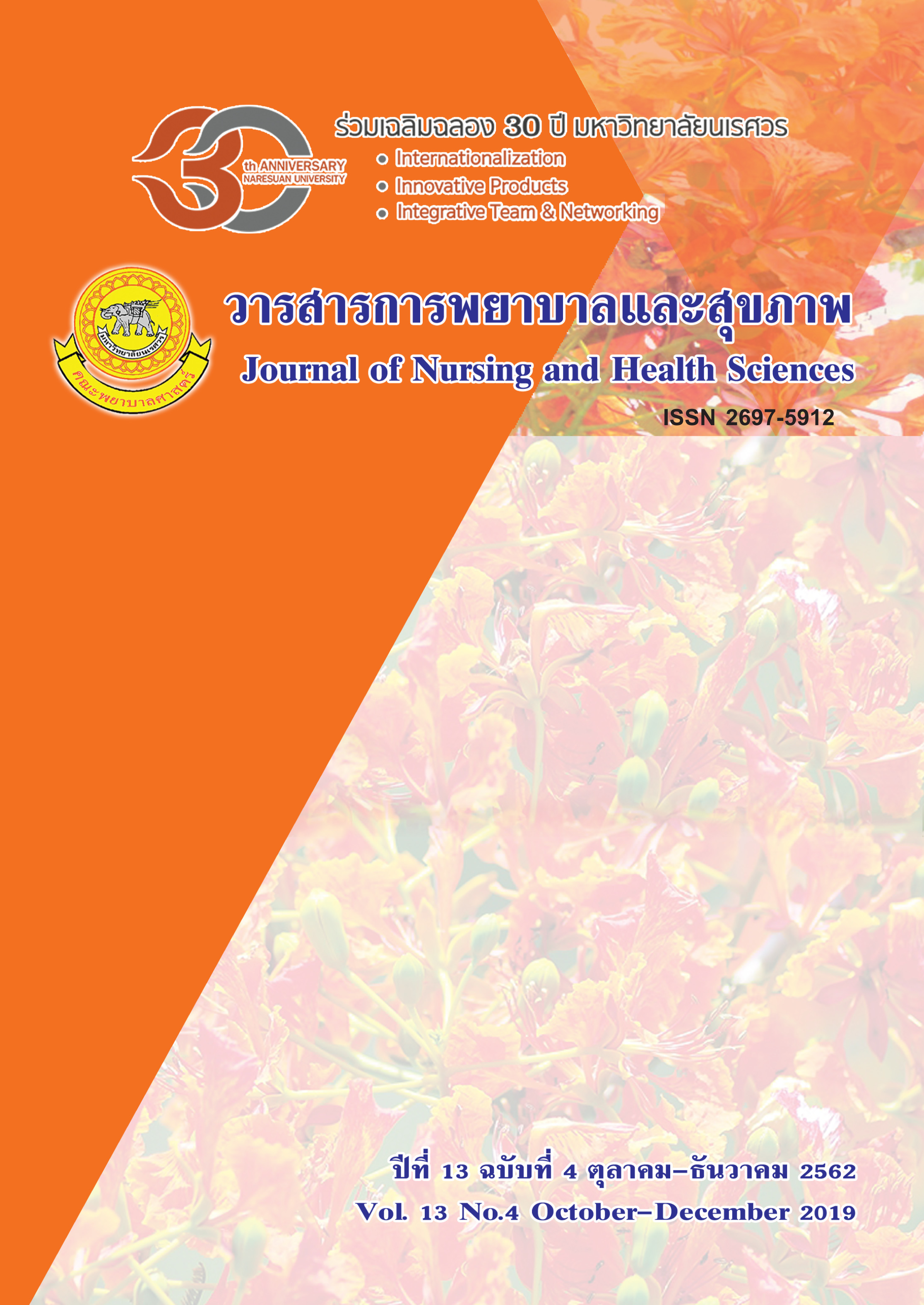ผลของการหายใจแบบห่อริมฝีปากต่อภาวะคงค้างของอากาศภายในปอดหลังการทดสอบ การทำกิจกรรมในชีวิตประจำวันในผู้ป่วยโรคปอดอุดกั้นเรื้อรัง
Main Article Content
บทคัดย่อ
การวิจัยครั้งนี้เป็นการวิจัยเพื่อศึกษาผลของการหายใจแบบห่อริมฝีปากในขณะที่ทำการทดสอบ การทำกิจกรรมในชีวิตประจำวันต่อปริมาตรคงค้างของอากาศภายในปอดหลังการหายใจออก ความอิ่มตัวของ ออกซิเจนในเลือด และความสามารถในการทำกิจวัตรประจำวันในผู้ป่วยโรคปอดอุดกั้นเรื้อรัง ในผู้ป่วยโรคปอด อุดกั้นเรื้อรังจำนวน 10 คน ที่มีอายุ 60 ปีขึ้นไป มีระดับความรุนแรงของโรคอยู่ในระดับปานกลางถึงหนัก รูปแบบการศึกษาใช้แบบสุ่มไขว้กลุ่ม แบ่งผู้ป่วยออกเป็นกลุ่มที่ทำการหายใจแบบห่อริมฝีปากและไม่ได้ทำ การหายใจแบบห่อริมฝีปากขณะทำการทดสอบการทำกิจกรรมในชีวิตประจำวัน ทุกคนจะได้รับการประเมินค่า ปริมาณของอากาศที่หายใจเข้าเต็มที่หลังจากหายใจออกตามปกติ ซึ่งแสดงค่าปริมาตรคงค้างของอากาศ ภายในปอดหลังการหายใจออก และประเมินค่าความอิ่มตัวของออกซิเจนในเลือด ก่อนและหลังการทดสอบ การทำกิจกรรมในชีวิตประจำวัน รวมทั้งประเมินระยะเวลาในการทำการทดสอบการทำกิจกรรมในชีวิตประจำวัน ผลการศึกษาพบว่ากลุ่มที่ทำการหายใจแบบห่อริมฝีปากขณะทำการทดสอบการทำกิจกรรมในชีวิตประจำวัน มีค่าปริมาณอากาศที่คงค้างภายในปอดหลังการหายใจออกลดลงและมีค่าความอิ่มตัวของออกซิเจนในเลือด มากกว่ากลุ่มที่ไม่ได้ทำการหายใจแบบห่อริมฝีปากอย่างมีนัยสำคัญทางสถิติ (p-value < 0.05) อย่างไรก็ตาม ผลการศึกษาไม่พบความแตกต่างของระยะเวลาในการทำการทดสอบการทำกิจกรรมในชีวิตประจำวันของ ทั้งสองกลุ่ม
Article Details
เอกสารอ้างอิง
Bhatt, S. P., Luqman-Arafath, T. K., Gupta, A. K., Mohan, A., Stoltzfus, J. C., Dey, T., . . . Guleria, R. (2013). Volitional pursed lips breathing in patients with stable chronic obstructive pulmonary disease improves exercise capacity. Chronic Respiratory Disease, 10(1), 5-10.
Calverley, P. M. A., & Koulouris, N. G. (2005). Flow limitation and dynamic hyperinflation: Key concepts in modern respiratory physiology. European Respiratory Journal, 25(1), 186-199.
Celli, B. R. (1988). Arm exercise and ventilation. Chest, 93(4), 673.
Celli, B. R., Rassulo, J., & Make, B. J. (1986). Dyssynchronous breathing during arm but not leg exercise in patients with chronic airflow obstruction. New England Journal of Medicine, 314(23), 1485-1490.
De Araujo, C. L. P., Karloh, M., Dos Reis, C. M., Palú, M., & Mayer, A. F. (2015). Pursed-lips breathing reduces dynamic hyperinflation induced by activities of daily living test in patients with chronic obstructive pulmonary disease: A randomized cross-over study. Journal of Rehabilitation Medicine, 47(10), 957-962.
Deesomchok, A., Webb, K. A., Forkert, L., Lam, Y. M., Ofir, D., Jensen, D., & O’Donnell, D. E. (2010). Lung hyperinflation and its reversibility in patients with airway obstruction of varying severity. Journal of Chronic Obstructive Pulmonary Disease 7(6), 428-437.
Gagnon, P., Guenette, J. A., Langer, D., Laviolette, L., Mainguy, V., Maltais, F., ...Saey, D. (2014). Pathogenesis of hyperinflation in chronic obstructive pulmonary disease. International Journal of Chronic Obstructive Pulmonary Disease, 9(1), 187-201.
Gigliotti, F., Coli, C., Bianchi, R., Grazzini, M., Stendardi, L., Castellani, C., & Scano, G. (2005). Arm exercise and hyperinflation in patients with COPD: Effect of arm training. Chest, 128(3), 1225-1232.
Global Initiative for Chronic Obstructive Lung Disease. (2018). Global strategy for the diagnosis, management and prevention of chronic obstructive lung disease (2018 Report). Retrived 5 March 2019 from https://goldcopd.org/wp-content/uploads/2017/11/GOLD-2018-v6.0-FINAL-revised-20-Nov_WMS.pdf
Jones, A. Y., Dean, Elizabeth, & Chow, C. C. (2003). Comparison of the oxygen cost of breathing exercises and spontaneous breathing in patients with stable chronic obstructive pulmonary disease. Physical Therapy, 83(5), 424-431.
Karloh, M., Karsten, M., Pissaia, F. V., de Araujo, C. L. P., & Mayer, A. F. (2014). Physiological responses to the Glittre-ADL test in patients with chronic obstructive pulmonary disease. Journal of Rehabilitation Medicine, 46(1), 88-94.
Miller, M. R., Hankinson, J., Brusasco, V., Burgos, F., Casaburi, R., Coates, A., ...Wanger, J. (2005). Standardisation of spirometry. European Respiratory Journal, 26(1), 319-338.
Mueller, R. E., Petty, T. L., & Filley, G. F. (1970). Ventilation and arterial blood gas changes induced by pursed lips breathing. Journal of Applied Physiology, 28(6), 784–789.
O'Donnell, D. E., & Webb, K. A. (2008). The major limitation to exercise performance in COPD is dynamic hyperinflation. Journal of Applied Physiology, 105(2), 753-755.
Panagiotou, M., Kastanakis, E., & Vogiatzis, I. (2013). Exercise limitation in COPD. Pneumon, 26(3), 245-256.
Pereira, M. C., Porras, D. C., Lunardi, A. C., Da Silva, C. C. B. M., Barbosa, R. C. C., Cardenas, L. Z., ...De Albuquerque, A. L. P. (2017). Thoracoabdominal asynchrony: Two methods in healthy, COPD, and interstitial lung disease patients. PLoS ONE, 12(8), 1-14.
Porto, E. F., Castro, A. A. M., Velloso, M., Nascimento, O. A., Maso, F. D., & Jardim, J. R. (2009). Exercises using the upper limbs hyperinflate COPD patients more than exercises using the lower limbs at the same metabolic demand. Monaldi Archives Chest Disease, 71(1), 21–26.
Rabinovich, R. A., & Vilaró, J. (2010). Structural and functional changes of peripheral muscles in chronic obstructive pulmonary disease patients. Current Opinion in Pulmonary Medicine, 16(2), 123-133.
Saffer, H., Dave, D., Grossman, M., & Leung, L. A. (2013). Racial, ethnic, and gender differences in physical activity. Journal of Human Capital, 7(4), 378-410.
Schenkel, N. S., Burdet, L., Muralt, B. d., & Fitting, J. W. (1996). Oxygen saturation during daily activities in chronic obstructive pulmonary disease. European Respiratory Journal, 9(12), 2584-2599.
Sin, D. D., Stafinski, T., Ng, Y. C., Bell, N. R., & Jacobs, P. (2002). The impact of chronic obstructive pulmonary disease on work loss in the United States. American Journal of Respiratory and Critical Care Medicine, 165(2), 704-707.
Tangri, S., & Woolf, C. R. (1973). The breathing pattern in chronic obstructive lung disease during the performance of some common daily activities. Chest, 63(1), 126-127.
Thoman, R. L., Stoker, G. L., & Ross, J. C. (1966). The efficacy of pursed-lips breathing in patients with chronic obstructive pulmonary disease. American Review of Respiratory Disease, 93(1), 100-106.
Thoracic Society of Thailand Under Royal Patronage. (2010). Guideline pulmonary function test. Retrived 5 August 2017 from http://thaichest.net/images/article/guideline/GuidelinePFT.pdf
Valeiro, B., Hernández, C., Aibar, J., Llop, L., Rodríguez, D. A., Barberán, A., ...Vilaró, J. (2012). Home exercise tolerance assessment in acute exacerbated COPD patientes. European Respiratory Journal, 40(1), 618.
Williams, R. E., & Horvath, S. M. (1995). Recovery from dynamic exercise. American Journal of Physiology-Heart and Circulatory Physiology, 6(2), 2311-2320.
Yan, S., Kaminski, D., & Sliwinski, P. (1997). Reliability of inspiratory capacity for estimating end-expiratory lung volume changes during exercise in patients with chronic obstructive pulmonary disease. American Journal of Respiratory and Critical Care Medicine, 156(1), 55-59.


